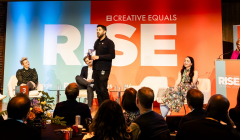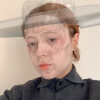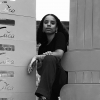
Are we leaving men and boys behind?
At Creative Equal’s RISE event, industry leaders consider how to reframe boys and men in marketing

In the face of the challenges of 2020 supporting, encouraging and celebrating the next generation has never felt more vital.

In the face of the challenges of 2020 supporting, encouraging and celebrating the next generation has never felt more vital. With degree shows cancelled and many workplaces implementing hiring freezes, it is beholden on the industry to acknowledge and make space for the brilliance of young creatives. Or risk missing out on the next generation of creative talent entirely.
This is at the heart of the MullenLowe NOVA Awards for Fresh Creative Talent, an extension of the sponsorship that the agency provides to the Central Saint Martins annual degree shows. The award celebrates some of the most exceptional work to come out of the college, giving students a platform for recognition and the opportunity to continue their practice after their graduation.
From 1,300 participating students, just five MullenLowe NOVA Awards are given out. This year the judges made the choice to celebrate the ingenuity of the students and their ability to push the boundaries of creative thinking in response to what was happening in the world around them.
“Now more than ever the importance of the power of creativity to solve real problems is evident”, as Jose Miguel Sokoloff, President of Global Creative Council, MullenLowe Group and Chief Creative Officer MullenLowe Group UK wrote.
We spoke to this year’s winners to find out more about how they brought their ideas to life, what their vision is for the future and what creativity really means to them.

Creativity is about interrogating existing systems, structures and thought patterns and generating something new from this interrogation.
Jahnavi Inniss
For this project I looked at the current presentations and lack thereof of Black British history and I saw the ways in which it is treated as insignificant and of minimal importance. I noticed frequent silent gaps in the timeline of Black British history, and I wanted to give visibility to the existence and contributions of Black people in Britain between the 17th and 19th centuries. I wanted to dismantle the ‘single story’ which suggests that Black people had only arrived in Britain after the Second World War in the late 1940s during the Windrush period. Seeing my ideas come to life was extremely fulfilling, especially due to the size and scale of my piece, each segment I added, the bigger it got. I began to see and understand the potential impact it could have.
For my creative vision for the future I hope to continue making work that provides a form of visibility and empowerment for underrepresented communities. I hope that my work continues to further stimulate discussion and lead to affirmative action within ongoing conversations regarding equality and social justice. I hope that these communities can get to a place where it no longer feels like an ongoing battle to be seen and heard.
To me, creativity means coming up with new and different ways of producing meaning. It's about interrogating existing systems, structures and thought patterns and generating something new from this interrogation

We don’t need more products to solve issues when the issues are driven by our own greed.
Joseph Standing

The idea behind my work was to try and get people talking about their water habits. How do your own consumer habits add to water pollution across the globe? How could you lessen your impact? The whole project wasn’t about solving the water crisis globally, but making people aware of what's behind it, and giving those same people the opportunity to change their ways. We don’t need more products to solve issues when the issues are driven by our own greed.
My vision for the future is to continue to undertake projects that expose issues, global or locally. I like the idea of being what I’d call an investigative journalist within industrial design, using my skill set to make hidden issues visible using industrial design.
Creativity is about finding something you’re passionate about and using any form of media and/or medium to convey that passion. It could be painting, or it could be journalism. Poetry or pottery. Using a skill set to express passion into a tangible outcome.

I think creativity is about putting imagination into action and materializing it.
Mathilde Rougier

The collection addresses damaged data and its restoration as a form of creation. The collection's aesthetic is based on a personal archive of garments. The archive was then recorded and manipulated digitally through photography, pixelation, 3D scanning and a convolutional neural network. These manipulations have inspired the aesthetic of the collection. The aim of the collection was to use what has already been produced, in terms of materials and inspiration, to produce new ideas, in short creating new with the old eternally. The motivating idea was to leave behind obsolescence and throw away fashion and replace it with more circular design solutions. The collection uses modular assembly to construct the garments. This process was inspired by pixels on a screen and allows for the elimination of waste in garment production and extends the life cycle of the garment.
The collection uses modular construction, where waste leather sample books, scraps and damaged hides are cut down into tessellating modules so a maximum of the material can be reused. These pieces are slotted together allowing them to be repositioned like LEGO. The garment can be changed by moving the modules, meaning the design process is constantly evolving and extending the life cycle of the garment. The second process is based on the re-use of single-use plastic packaging from the fashion industry to make accessories. The plastic can be re-melted into other designs as it is kept un-mixed. Neither of these processes use sewing, meaning the garments are built for disassembly and are recyclable, as material unity is conserved. The third process is based around the upcycling of ripped or stained 100% cotton hotel sheeting. These garments are sewn using 100% cotton thread. They are also dyed using China ink, which doesn't need a chemical mordant. The last process uses augmented reality to plane track the garments in order to evolve their shape in the digital plane.
The future is going to have to be sustainable. We are going to observe new ethical models, tech innovations and production systems focused on eradicating waste and producing garments that last, by people paid fairly. The other major evolution the fashion industry is going to go through is digitization. We’ll have two wardrobes: one virtual dressing our digital identities, the other analogue for our IRL self.
Creativity, to me, is about problem solving. I have a social design approach; I have to be addressing a flaw in our society. I think creativity is about putting imagination into action and materializing it.

Create what is missing, fill the gaps, draw connections, improve something.
Sandra Poulson

‘AN ANGOLAN ARCHIVE’ is an archival assemblage of information explored through documents, artefacts, garments, moments, headlines, oral tradition and historical data, that define the sociocultural, economic, political, ethnic and cultural landscape of Angola, focused specifically on Luanda. It operates as an instigator for action towards progress by creating an opportunity for individual agency, for one to ‘discuss their own story’ and by all means tell it. This work acknowledges that an archive is colonial in outlook. Therefore, the task of decoloniality is central to ‘AN ANGOLAN ARCHIVE’, as the notion of African-led own archives is still to confront the current realities being depicted by external bodies. Seeing the intention of the work come to life has been a really insightful and gratifying process. In a way the resolution of this stage of the project has been really effective at communicating itself, while very influenced by the circumstances of lockdown in which most of the artefacts were produced. But also, the work is the starting point for the many conversations that I am willing to host, and that is really exciting.
I am continuing to develop my practice, research and produce work. While operating in the mediums the different conversations require, in a way working in a borderless way between practices, as the most important thing for me is the vision of the work. I am currently setting up a studio space in London which I am sharing with a friend. I am also joining a mentorship programme for the class of 2020 with XYZ Exchange, which is really exciting and gives me a lot of hope. I already have some projects lined up for 2021, mostly involving collaborations and exhibitions. Unfortunately, I cannot get into details about those as they aren’t yet public knowledge.
I see creativity as the ability to respond to a ‘lack’. It could be the lack of resources, solutions, networks etc. In my practice ‘lack’ has been a core driving aspect, which in many ways has been with me since my childhood. Create what is missing, fill the gaps, draw connections, improve something. I tend not to glamorise creativity, and rather see it as an important mechanism for progress.
Looks like you need to create a Creativebrief account to perform this action.
Create account Sign inLooks like you need to create a Creativebrief account to perform this action.
Create account Sign in